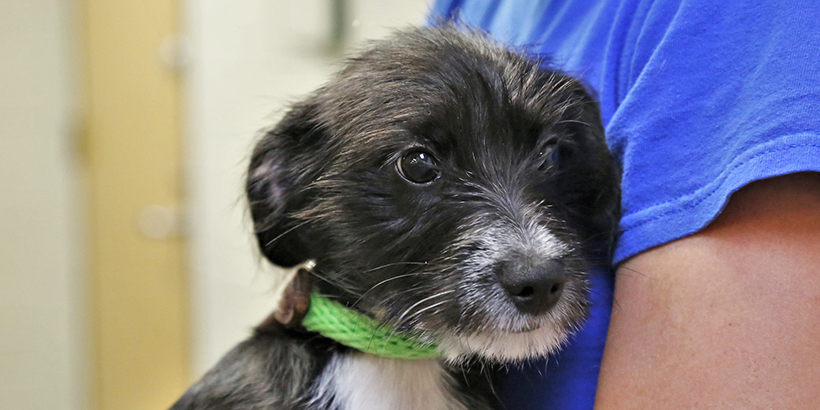
A shy dog can have a difficult time transitioning into a new environment. These dogs require a lot of patience from their new family in order to build trust and settle into their home. A good way to start is getting to know your dog’s stress signals and remembering to stick to a consistent schedule. Remember, a shy dog should never be left alone in a fenced yard or on a tie-out.
Here are some tips on how to remain positive and consistent while working with your new dog.
Equipment
Any dog who is considered shy or a flight risk should be equipped with “escape-proof” walking gear such as a martingale collar or a harness lead.
- Remember to check the fit before each outing.
- Use a nylon leash rather than a retractable one. If dropped, retractable leashes can cause more fear because they may be perceived as “chasing” the dog as they run.
- To prevent your dog from running through the doorway, you can install a gate system in the home near exits using baby gates or puppy playpens.
Plan your walk
When a dog is new to your home, they will not know your neighborhood. Before going for a walk, think about how to avoid circumstances that could scare your dog. This could include loud vehicles, crowds of people, other dogs, etc.
- To start, choose calmer times and places to walk so that your dog will not be frightened by a lot of chaos. Ex: Wooded areas, quiet back roads, etc.
- While walking, always be aware of your surroundings. Watch for potential triggers and move in the opposite direction if you see something scary approaching.
Positive, slow introductions only
Most shy dogs need help learning that new people are friends.
- While on walks, it is important that you communicate with people, asking them not to approach your dog. Each time a stranger walks by, feed your dog a small training treat to form a positive association with strangers approaching.
- If there are new people coming into your home, offer your dog a spot to use as a “safe place,” such as a crate or gated-off room. Tell your guests that if the dog enters this space, it means they are off-limits for interaction.
- Have guests interact with your dog only if your dog approaches them. Keep petting to a minimum and have them offer a favorite snack or toy from a distance.
- Always have new people move slowly and talk quietly while around your dog.
Specific rewards
Find out what your dog’s favorite reward is and use this only in new situations. This could be a particular food, toys, or affection from you.
Additional help
If you feel your dog still needs a little extra support, consider using Adaptil products or a Thunder Shirt. (Please see manufacturer details for proper use).
Preparing for veterinary appointments
If veterinary visits are particularly overwhelming for your pup, consider asking your veterinarian to book your appointments at a less busy time. You may also be able to schedule them so you can immediately go into a room, rather than wait in the lobby. Make sure to make all visits as stress-free and fun as possible. Fear-free certified veterinary offices are available in most areas.
Shy dogs just need a little extra adjustment time. With time, your dog will give you all the love they have.
